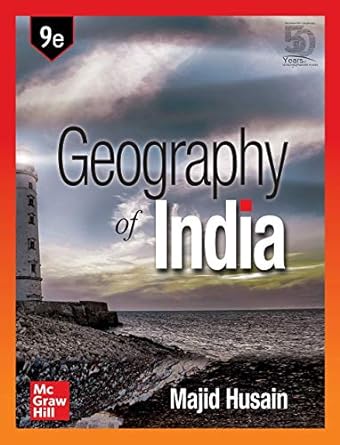
Subject & College
Series
Publisher, Place
Total Pages
912
ISBN 13
978-93-90185-71-9
Format
Paperback
Country
India
Language
English
Readers Feedback
Geography of India
This book is mainly related to the Geography of India and covers all aspects of India's climate, seasons, communication, Agriculture, energy resources available in India,...Read More
Ajit Dumbre
Geography of India
This book is mainly related to the Geography of India and covers all aspects of India’s climate, seasons, communication, Agriculture, energy resources available in India, Industries, etc. It is published by McGraw Hill Education (India) Private Limited and is in its Ninth Edition.
Geography is a Greek word. The meaning of Geo means Earth and Graphy means to write. Like other subjects that we learn in our career, Geography is one of the most important subjects not only from an examination point of view but also in enhancing general Knowledge. This subject is related to everybody’s daily routine. It studies weather, natural happenings, and global conditions, also study including local or regional climates, nature, ocean, population, Mountains, flora- and fauna, etc.
Majid Husain’s Geography of India is widely regarded as a comprehensive and in-depth study of India’s physical, economic, and social geography.
Key Features:
1. Comprehensive Coverage: The book covers a wide range of geographical topics, including the physical features of India (mountains, rivers, plains, and deserts), climate, natural resources, agriculture, industries, and population. It also delves into contemporary issues like environmental challenges, urbanization, and the effects of globalization on India’s geography.
2. Detailed Maps and Diagrams: Husain’s book is rich in well-labeled maps, diagrams, and illustrations that help readers better understand geographical concepts. These visuals are essential for grasping the spatial relationships of geographical features and regions in India.
3. Clarity and Simplicity: The author presents complex geographical concepts in a clear, straightforward manner, making it easy for readers to comprehend even difficult topics. The language is simple, and the explanations are systematic, which makes the book suitable for students at different levels of study.
4. Inclusion of Current Trends: Husain integrates contemporary geographical issues like urban sprawl, the impact of climate change, water resource management, and environmental concerns. This makes the book not only a valuable academic resource but also relevant to real-world scenarios.
5. Up-to-date Content: The book is regularly updated to reflect changes in geographical data and emerging trends. This helps ensure that the book remains a reliable reference for students.
Strengths:
• Thoroughness: It provides an exhaustive and systematic examination of Indian geography, making it a one-stop resource for learning.
• Student-friendly: Its clear writing style, combined with practical examples and case studies, makes it particularly accessible for beginners.
• Reliable for Competitive Exams: For aspirants of UPSC and other competitive exams, the book provides all the necessary information in a concise and organized manner.
Critiques:
• Dense for Casual Readers: The level of detail might be overwhelming for casual readers who are not focusing on academic or exam-based study. While the book is excellent for students, those seeking a more introductory or lighter overview of India’s geography may find it somewhat dense.
• Occasional Overemphasis on Facts: Some readers might feel that the book can at times become overly fact-heavy, without delving too deeply into the underlying causes or socio-political contexts of certain geographical phenomena.
Conclusion:
Geography of India by Majid Husain is an authoritative, detailed, and well-structured book that serves as an essential resource for students of geography and anyone interested in understanding the geographical landscape of India. Its strength lies in its thoroughness, clarity, and utility for competitive exams. However, its depth might be more suited for academic or serious study rather than casual reading.
